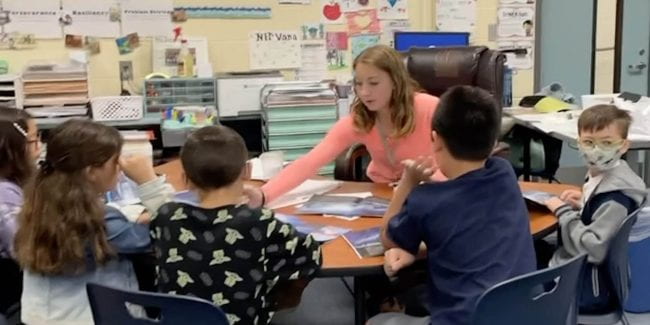
Cole Sussman, BSEd ’21, Elementary Education
Fourth Grade
Spring Valley Elementary, Midway ISD
My first year of teaching was in fourth grade reading/language arts and social studies at Midway’s Spring Valley Elementary. And I just started my MA in Curriculum and Instruction this summer, which I’ll work on while I continue to teach; I’m planning to write my thesis on equitable literature curriculum.

My favorite thing about teaching is challenging all students. This means listening well and having deep relationships with my kids. And it also means knowing what they can do (not just what they can’t) academically. I love working with my kids and integrating their needs with curriculum.
Public school has so many expectations and restrictions, but I think it’s so important to continually put students first. I love learning about my students’ backgrounds and getting a full picture of who they are. Then I can use texts and pull in examples that build off their background knowledge. It also helps me differentiate based on where they are in relation to the skills we’re learning. I want to challenge all my kids to learn something new every day. And that means that usually everyone learns something different. One student may learn how to express frustration without anger, another may learn what symbolism is, and another may learn what sounds “ou” makes. It’s my job — and my joy — to be aware and tapped in to all of these things, so each student is comfortable, known, valued, and challenged in our learning environment. It feels like one giant puzzle to me to balance 44 kids, the curriculum, and their affective needs, and I love it!

I had some really amazing moments this year with individual students who were challenged to learn for the first time. Some were chronic underachievers who no longer believed they could learn. Others had never been pushed to learn at their level because they already knew the mandated curriculum. Each “aha” moment was such a victory for us as a learning community and really encouraged me to keep fighting for each student.
My favorite moment though was with my most advanced readers. I placed a student in this group who had not fully demonstrated capability, but I thought the challenge might bring out the depth in him that he didn’t usually display. For background, this student was the class trouble-maker, and everyone knew him as the sly, funny rebel, undervaluing his exceptional academic ability which no one, including this student himself, recognized due to his behavior.

I had chosen a difficult text about a troubled boy who joins a track team and has to learn how to be a teammate (in my heart of hearts, it was specifically for my little rebel). The character’s background came from abuse, and he ran because it helped him forget. We were discussing the deeper meanings of the book as we reached the end of the novel study. I asked my students the meaning of a quote from the coach character that went something along the lines of, “You can’t run from yourself.” I received silent stares in response as they eliminated any literal meaning and began to think through the figurative. Then my sweet trouble-maker spoke up and said, “It means that you can’t escape who you really are; you have to face it and learn from it.” He went on to tie this to the symbolism of colors in the book — red when the character was angry, black when he was remembering hardships, silver for hope. We had talked about none of these things, and hearing this student connect all the dots shocked everyone. His classmates stared for a moment, and then a lively discussion began — coming up with ideas, flipping back to find examples of colors and emotions, interpreting the quote and predicting what would happen next. I got to watch proudly as the students’ respect for each other grew and the shared understandings of the text went way deeper than I would have tried to extend. I am so proud of the respect for each other this moment produced, and it’s the kind of dialogue I want to cultivate more and more often in my classroom.
All that to say, I am so thankful for my first year. I learned so much, and I have so many ideas on how to improve for next year. I want to keep pushing my students to grow and helping them build to their next thing. And I definitely want to keep growing in how I cultivate a classroom community, especially for my kiddos with tough behaviors. I’m thankful for the training Baylor gave me, the safety of getting my feet wet through intern year, and the joy of finding my own way in my first classroom.
